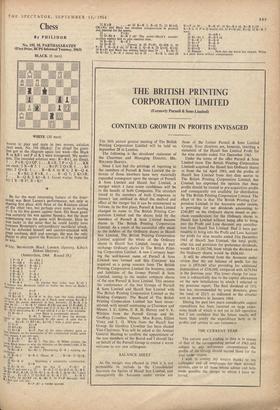Chess
• By PHILIDOR No. 195. M. PARTHASARATHY (First Prize, BCPS Informal Tourney, 1963) BLACK (8 men) WHITE (10 men)
WHILE to play and mate in two moves; solution next week. No. 194 (Hicks): I'm afraid the grem- lins got at the diagram again last week—the Black R at KB 1 and P at K 2 were transposed. My apolo- gies. The intended solution was: R—B 6!, no threat. 1 ..'.PXR; QxQP. 1 ...RXR; 2P= Q. 1. . KR on rank; 2 R—B 5. 1 ... BXP; 2 Q X B. I — Kt any; 2 Q X B. 1 . .R—K 6 Or B 6; 2 R—Q 4. 1 . . . R x Kt; 2 B >CR. 1 . . . R—Q 7; 2 Kt XR. I . . . R—Q 8; 2 Kt—K 1. Good waiter. Note the try 1 R---B 4?, R x Kt!
By far the most interesting feature of the Inter- zonal was Bent Larsen's performance, not only in Sharing first place with three of the Russians ahead Of the other two, but perhaps even more in scoring 3-2 in his five games against them. His finest game Was certainly his win against Spassky, but the most entertaining was his game with Bronstein. Here he i Was lucky n the sense that he could hardly have foreseen Bronstein's extraordinary sacrificial attack, but he defended himself and counter-attacked with great coolness, skill and courage. He was the only Player to play against the Russians as if he expected to win.
14//iite, -BRONSTEIN. Black, LARSEN. Opening, KING'S
INDIAN DEFENCE.
(Amsterdam, 1964. Round 19.)
t P—Q 4 Kt—KB 3
2 P—QB 4 P—KKt 3
3 Kt—QB 3 B—Kt 2
4 P—K 4 P—Q 3 5 B—K 2 0-0 6 B—Kt 5 P—B 4
7 P—Q 5 .P—K 3 S Kt—B 3 P—KR 3
B—B 4 . . . In playing here rather than B—Q 2 1 believe that Bronstein fulled to realise the force of Black's eleventh move.
9 P x P
10 KPxP R—K 1 11 Kt—Q 2 Kt-11. 4! At first sight this looks pointless
'ince if 12 11-1( 3 it looks as if Black must retreat Kt—B 3 or have his pawns shattered; in fact, however, 12 B—K 3 is
LUet by 12, Q—R 5! (threat Axil) and now 13 P—KICt 3, S—R 6 is dangerous for White and 13 0--0, Kt—B 5; 14 B-11 3, 41--Q 6! threatening Kt xP and with K 4 or Kt 5 also available.
12 B—Kt 3 — . now Black is comfortably placed. 12 , B—Kt 5. Moves 13-18 show the develop-
tent of the plan inaugurated by. this move. A safer line is 12. Kt xB; 13 RP xKt, Kt=-Q 2 with a good game.
i3 Kt XB 14 RPxKt BxB
t, 15 KtXB pxP. Part of the plan—ahether good or
"d depends on the 'assessment of the complicated middle game that ensues: 1 ant not sure.
16 R—Kt I B—Kt 2
17 RxP Kt—Q 2. The idea. If White retreats the rock Black hopes to seize the initiative on the queen's side; if he 'eel'S it there . . we shall sec.
18 Kt—B 4 Kt—Kt 3. Threatening Q—B 1 winning the exchange. 111 R—K 1 13—B 6. Threat 20 . . . R XR; 21 QXR, ICLX/IP.
20 Kt—K 4!. Beginning a remarkable combination. 20 . . 13x12
rs21 Kt—K 6!! . . . with the idea 21 . . . PXKt?; 22
t 4! and wins e.g. 22 .. . —K 2; 23 QxKtP ch, K—B 1;
44 Kt—.J 6!, R xR; 25 Q—Kt 8 ch, K—K 2; 26 Q—Kt 7 mate 0r22. . Ki—Q 2; 23 QxKtP eh, IC—R 1(23 . . K—B 1; ss" PXP); 24 QxRP ch, K—Kt 1; 25 PXP (stronger than t‘XKt) and will win.
llxP eh!! a worthy cOunter.
22 KXB • . . or 22 K—R 2, B—Q 5!; 23 KtxQ, QRXKt; and Black has excellent compensation in position and material for the queen.
22 PxKt 23 s.F—x.s 4 R—B chi The point—Black's counter- sacrifice enables him to gain essential time.
24 K—Kt 1 R—B 3 25 Q—R 37 . . . Correct is 25 PXP1, Q—KB I; 26 P—K 7, R—B 8 ch; 27 K—R 2, Q—B 4; 28 QXQ, R X Q; 29 RX11 and Black has nothing better than 29 . . . Ft—Kt 1; 30 R—Kt 7, R—R 1 drawn fur if 29 . . . R—K 1; then 30 KtxP or 29 . . . R—I( 47; 30 Kt—B 6 ch, K—R 1(30 . . K—B 2; 31 P Q double ch); 31 P=Q eh!, R>sQ; 32 R—R 7 mate.
25 . . . Q—KB 1
26 Kt—Kt 5 R—B 8 cb 27 K—R 2 It—B 4!
28 KtX P R—R 41 29 QXR • PxQ
30 KtXQ R X Kt
31 Resigns . . Now that the battle has cleared. White
h a piece down without compensation.






























 Previous page
Previous page